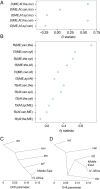Cross-species hybridization and the origin of North African date palms
- PMID: 30642962
- PMCID: PMC6358688
- DOI: 10.1073/pnas.1817453116
Cross-species hybridization and the origin of North African date palms
Abstract
Date palm (Phoenix dactylifera L.) is a major fruit crop of arid regions that were domesticated ∼7,000 y ago in the Near or Middle East. This species is cultivated widely in the Middle East and North Africa, and previous population genetic studies have shown genetic differentiation between these regions. We investigated the evolutionary history of P. dactylifera and its wild relatives by resequencing the genomes of date palm varieties and five of its closest relatives. Our results indicate that the North African population has mixed ancestry with components from Middle Eastern P. dactylifera and Phoenix theophrasti, a wild relative endemic to the Eastern Mediterranean. Introgressive hybridization is supported by tests of admixture, reduced subdivision between North African date palm and P. theophrasti, sharing of haplotypes in introgressed regions, and a population model that incorporates gene flow between these populations. Analysis of ancestry proportions indicates that as much as 18% of the genome of North African varieties can be traced to P. theophrasti and a large percentage of loci in this population are segregating for single-nucleotide polymorphisms (SNPs) that are fixed in P. theophrasti and absent from date palm in the Middle East. We present a survey of Phoenix remains in the archaeobotanical record which supports a late arrival of date palm to North Africa. Our results suggest that hybridization with P. theophrasti was of central importance in the diversification history of the cultivated date palm.
Keywords: archaeobotany; crop wild relative; domestication; introgression; range expansion.
Copyright © 2019 the Author(s). Published by PNAS.
Conflict of interest statement
The authors declare no conflict of interest.
Figures





References
-
- Barrow SC. A monograph of Phoenix L. (Palmae: Coryphoideae) Kew Bull. 1998;53:513–575.
-
- Zehdi S, et al. Molecular polymorphism and genetic relationships in date palm (Phoenix dactylifera L.): The utility of nuclear microsatellite markers. Sci Hort. 2012;148:255–263.
-
- Arabnejad H, Bahar M, Reza Mohammadi H, Latifian M. Development, characterization and use of microsatellite markers for germplasm analysis in date palm (Phoenix dactylifera L.) Sci Hort. 2012;134:150–156.
-
- Cherif E, et al. Male-specific DNA markers provide genetic evidence of an XY chromosome system, a recombination arrest and allow the tracing of paternal lineages in date palm. New Phytol. 2013;197:409–415. - PubMed
Publication types
MeSH terms
Substances
Associated data
LinkOut - more resources
Full Text Sources
Other Literature Sources

